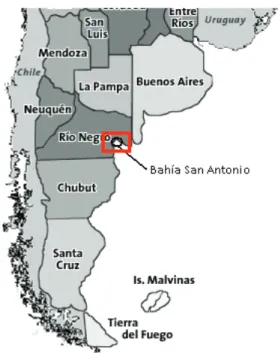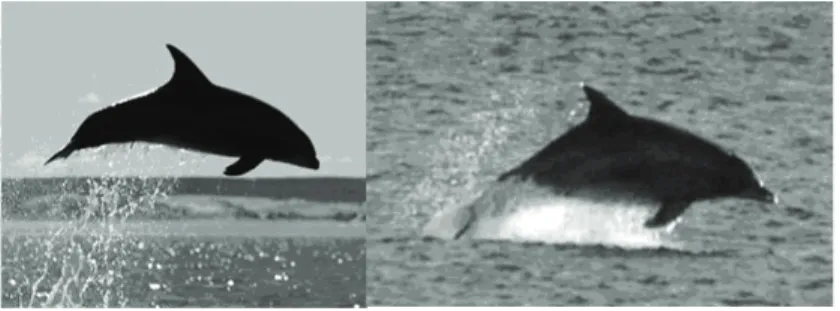Variation in external morphology of resident bottlenose dolphins in
Bahía San Antonio, Patagonia, Argentina
Els Vermeulen and Alejandro Cammareri
Marybio Foundation, Conaniyeu 475, Las Grutas, Río Negro, Argentina
Abstract
A photo-identification study carried out in Bahía San Antonio (Patagonia Argentina) showed a variation in external morphology among year-round resident
bottlenose dolphins. Out of 63 individually identified bottlenose dolphins, 15 were considered year-round residents of which three show variations in external morphology: they have a more falcate dorsal fin, darker coloration and shorter beak, physical characteristics described for the regional form of bottlenose dolphins present in the more southern province Chubut. The three morphologic distinct individuals, with one associated calf, could be re-identified in the study area up to 10 times over all the different seasons and up to now, no other bottlenose dolphins with similar characteristics could be observed in the area. On all occasions, they were re-identified in close occasions with each other and on 8 occasions in close association with other identified individuals. So far it was believed that the two regional forms of bottlenose dolphins present in Argentina were isolated. This communication is meant to document the residency and interaction of both regional forms in the same area. [JMATE. 2009;2(2):3-6]
————————————————————————
Introduction
The taxonomy of bottlenose dolphins has been a debate for a long time. At this moment two species of
Tursiops are recognized being T. truncatus the common
bottlenose dolphin and T. adunctus the Indo-Pacific bottlenose dolphin. In South America, the species
Tursiops gephyreus was originally used for bottlenose
dolphins from the southern Atlantic coast. However, its use gradually decreased when the morphological
plasticity of the genus was recognized (2). Nowadays,
up to 20 morphotypes are described worldwide but geographic variation remains poorly understood.
In Argentina, two geographic variations of bottlenose dolphins were described by Bastida &
Rodriguez in 2003 (3). The bottlenose dolphins living along the coasts of the province of Buenos Aires are characterized by their triangular dorsal fin shape whereas bottlenose dolphins living more south along the coasts of the province of Chubut are characterized by their falcate dorsal fin shape. Bastida & Rodriguez further stated that ‘their clear difference would indicate that both geographic forms are isolated’ (3). Although it still remains unknown to which extent this morphologic variation is genetically correlated, this communication is meant to document the residency and interaction of both regional forms in Bahía San Antonio (province of Río Negro; Figure 1).
Figure 1: Map of the coast of Argentina indicating the
study area.
Received September 6, 2009; Accepted December 15, 2009. Correspondence: Els Vermeulen and Alejandro Cammareri
Marybio Foundation - Conaniyeu 475, Las Grutas, Río Negro, Argentina Email: els@marybio.org
Journal of Marine Animals and Their Ecology
Copyright © 2008 Oceanographic Environmental Research Society Printed in Canada Vol 2, No2, 2009
JMATE 3
Resident dolphins in Bahía San Antonio, Argentina
Methods
A photo-identification study was made in Bahía San Antonio (BSA) (Figure 1) , a shallow bay (maximum depth <30 m), located in the northern region of the San Matías Gulf (40°50’S 64°50’W), Patagonia Argentina. The region is known for large seasonal
fluctuations in sea surface temperature (up to ±16°C) and relative high salinity compared to the waters further south in the gulf (5). Boat-based observations were made from August 2006 up to August 2009. When dolphins were seen, an attempt was made to photograph the dorsal fins of all individuals in the group, regardless the
presence of clear marks.
All clear pictures of dorsal fins were analysed using the computer assisted identification systems FinEx and FinMatch (EC EuroPhlukes Initiative, University of Leiden, The Netherlands). Marked dolphins were
catalogued with the code RN-BSA-M(n°) standing for ‘Rio Negro – Bahía San Antonio – Marybio (N°)’. Residency patterns were analysed regarding the presence or absence of dolphins in different seasons: Summer = January-February-March; Autumn = April-May-June; Winter = July-August-September; Spring = October-November-December. Dolphins re-identified during all four seasons (regardless of year) were defined as year-round residents while those re-identified only in specific seasons in two consecutive years were defined as seasonal residents (14). Calves were categorized as having 2/3 or less the length of an adult and mostly swimming in close association with an adult. Identified dolphins closely accompanied by a calf in at least two sightings were assumed to be females (6,7). Data on behaviour were recorded following the definitions of Bearzi (5), using a focal group five-minute point
sampling mode (1,8), meaning that every five minutes, a point sample is taken of the predominating behaviour in the group.
Results
A total of 63 bottlenose dolphins could be indi-vidually identified due to their distinctive markings of which 15 were considered as year-round residents in the study area. Three of these year-round residents and one calf (RN-BSA-M55, M56+calf, M57) were noted to show variations in external morphology when compared to the other 62 catalogued dolphins, being
Distinguishable by a more falcate dorsal fin (Figure 2), a darker coloration (Figure 2) and a notably shorter beak (Figure 3).
Figure 2: Variation in dorsal fin shape of year-round
resident bottlenose dolphins. Left: RN-BSA-M39 and RN-BSA-M57. Right: adult females RN-BSA-M56 and RN-BSA-M6.
Figure 3: Comparison of external morphology of
bottlenose dolphins in BSA. Left: bottlenose dolphin RN-BSA-M55, year-round resident in BSA. Right: bottlenose dolphin RN-BSA-M31, year-round resident in BSA.
This group of four morphological distinct
bottlenose dolphins (M55, M56+calf and M57) were first observed inside BSA in September 2008 and were re-identified in this area on 10 different occasions since then, divided over all four seasons. On eight of these occasions, they were observed in close association with other catalogued bottlenose dolphins in groups of 11 individuals on average (SD=7) ranging from 6 to 25. On all times M55, M56+calf and M57 were seen in close association with each other and no other bottlenose dolphin with similar characteristics could be observed in the area up to now. An additional recapture of M55, M56+calf and M57 could also be made in Puerto Lobos, 150km south of the study area and at the border of the province of Chubut.
JMATE
Vol 2, No2, 2009
Printed in Canada
Resident dolphins in Bahía San Antonio, Argentina
In further instance, the behaviour of the dolphin groups that included both forms could be observed in BSA during 380 min in total. These observations
indicated that these dolphin groups spent 18% of their time feeding, 18% socialising, 17% slowly travelling and resting, 16% travelling in medium and fast speed and 7% milling. In total 24% of the behaviour could not be classified accurately.
Discussion
Four of the frequently observed bottlenose
dolphins in BSA show variations in external morphology when compared to all other bottlenose dolphins observed in the study area. Similar characteristics were described for the bottlenose dolphins present in the area of the province of Chubut (3), studied by Würsig during the period from 1970-1980 (10-13). Würsig & Würsig were able to identify up to 53 bottlenose dolphins in the province of Chubut, all falcate dorsal fin shaped, and described these bottlenose dolphins as ‘coastal’ as they appeared 92% of their time in waters <10 m deep (12). Under the hypothesis that these four morphological distinct bottlenose dolphins are part of the population described in Peninsula Valdes based on their external characteristics, and based on the fact that the bottlenose dolphins in BSA were documented as coastal by
Vermeulen & Cammareri (9), the mentioned
differentiation may not be of the kind ‘inshore vs. off-shore’.
The behavioural interaction between both forms did not indicate a preferred behaviour during
associations. Nevertheless, the relative high amount of observed socializing behaviour between both forms indicates the need of a continued monitoring. It seems also remarkable that only four of these individuals could be observed in BSA during a three-year study. And although it seems very preliminary to refer to on the presence or absence of intermediate characteristics, up to now, on all occasions a rather clear differentiation could be made between the two variations.
Although both forms show variations in external morphology, the extent to which this phenotypic
variation is genetically correlated remains unknown. A clear insight on the differentiation between these
regional forms might have important conservation
implications for this species in Argentina. Further research and detailed studies seem therefore vital for the conservation of the species in Argentina.
Acknowledgments
Field research was supported by Cetacean Society International and Trigon N.V. Thanks to the Environmental Agency of Río Negro (Consejo de Ecología y Medio Ambiente de Río Negro [CODEMA]) and the Wildlife Service of Río Negro (Dirección de Fauna de Río Negro) for the field permits.
References
1. Altmann J. Observational study of behaviour: Sampling methods. Behaviour, 49, 227-265.
1974.
2. Barreto AS. Tursiops in Atlantic South America: Is Tursiops gephyreus a valid species? Abstract
at the Symposium on Cetacean Systematics, La
Jolla, California. 2004.
3. Bastida R & Rodríguez D. Mamíferos marinos de Patagonia y Antártida [Marine mammals of Patagonia and Antarctica]. Buenos Aires:
Vazquez Mazzini. 2003.
4. Bearzi M. Aspects of ecology and behaviour of bottlenose dolphins (Tursiops truncatus) in Santa Monica Bay, California. Journal of Ceta
cean Research and Management, 7, 75-83.
2005.
5. Gagliardini DA & Rivas AL. Environmental characteristics of San Matías Gulf obtained from land-sat—TM and ETM+ data. Gayana
(Concepción), 68, 186-193, 2003.
6. Grellier K, Hammond PS, Wilson B, Sanders-Reed CA, & Thompson PM. Use of photo-identification data to quantify mother-calf asso ciation patterns in bottlenose dolphins. Cana
dian Journal of Zoology, 81, 1421-1427. 2003. 7.
Mann J & Smuts B. Behavioural development in wild bottlenose dolphin newborns (Tursiops sp.). Behaviour, 136, 529-566. 1999.
8. Mann, J. Behavioural sampling methods for cetaceans: A review and critique. Marine Mammal
Science, 19, 102-122, 1999.
9. Vermeulen E & Cammareri A. Residency Patterns, Abundance and Social Composition of Bottlenose Dolphins (Tursiops truncatus) in Bahía
San Antonio, Patagonia, Argentina. Aquatic
JMATE
Vol 2, No2, 2009
Printed in Canada
Mammals, 35 (3), 379-386. 2009.
10. Würsig B & Würsig M. The photographic determination of group size, composition and stability of coastal porpoises (Tursiops truncatus). Science, 198, 755-756. 1977.
11. Würsig B. Occurrence and group organization of Atlantic bottlenose porpoise (Tursiops truncatus) in an Argentine bay. The Biological Bulletin, 154, 348-359. 1978.
12. Würsig B & Würsig M. Behaviour and ecology of bottlenose porpoises, Tursiops truncatus, in the South Atlantic. Fishery Bulletin, 77, 399- 442. 1979.
13. Würsig B. Aspects of the natural history of bottlenose and dusky dolphins. National
Geographic Society, Research reports 1975
projects, 759-768. 1984.
14. Zolman ES. Residence patterns of bottlenose dol-phins (Tursiops truncatus) in the Stono
River Estuary, Charleston County, South
Carolina, U.S.A. Marine Mammal Science, 18, 879
-892. 2002.
Resident dolphins in Bahía San Antonio, Argentina
JMATE
Vol 2, No2, 2009
Printed in Canada

